#pamela werner
Text




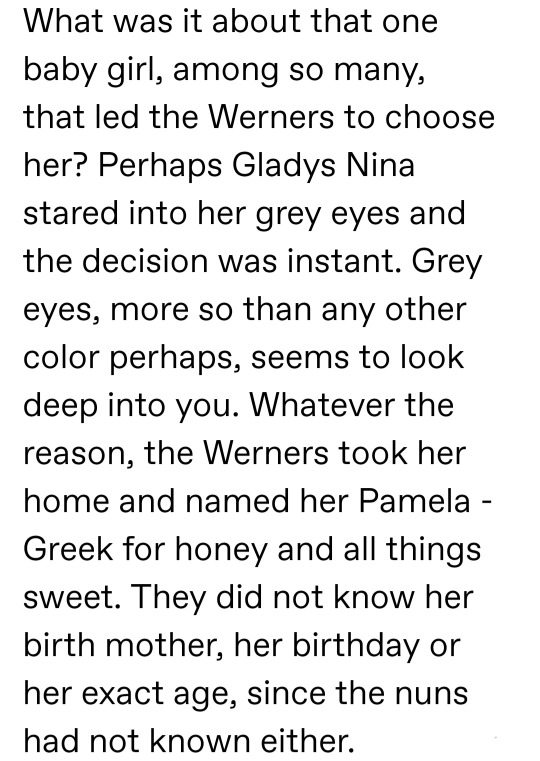


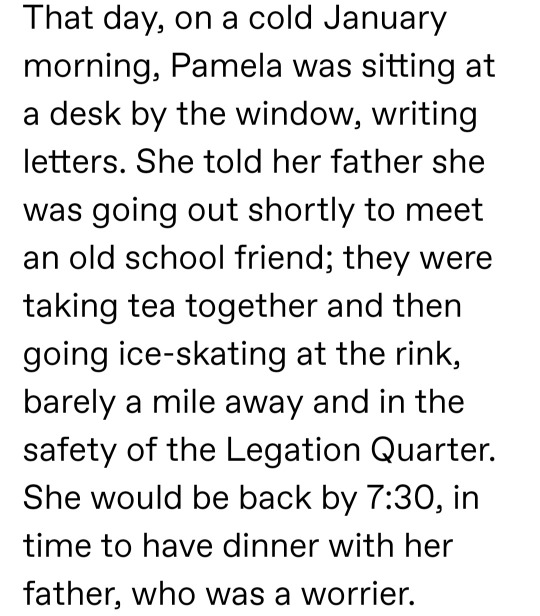
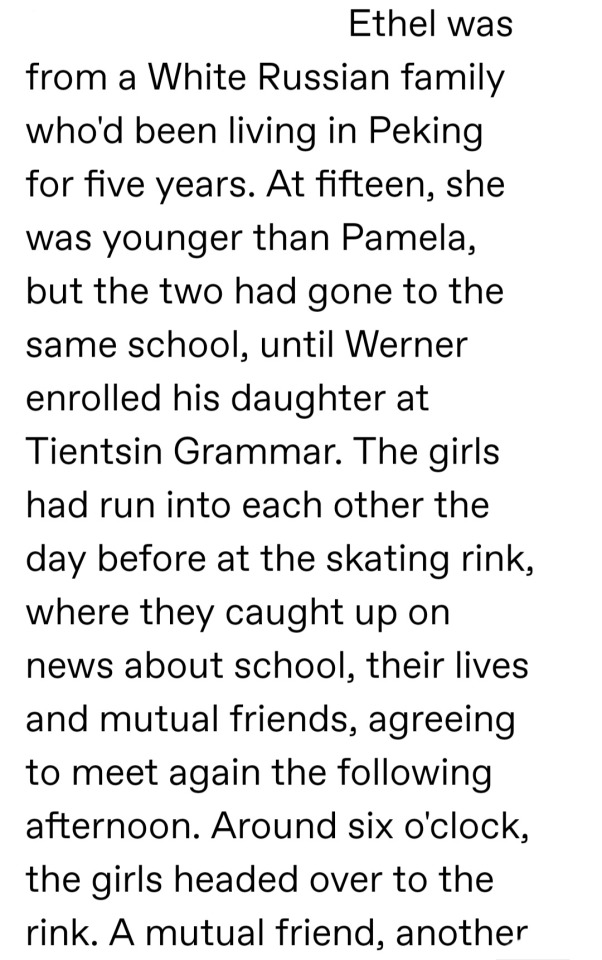

dark. They both lived nearby, within the Quarter, and were staying out later than normal on account of it being Russian Christmas, but Pamela would have to ride a mile or so outside the Quarter to Amour Factory Alley, skirting the notorious Badlands by riding along the Tartar Wall. Then she'd be pedaling through the Tartar City in the dark, with not even moonlight to help. The only landmarks at night would be the spindly spires of St. Michael's Church, the lights in the upper windows of the Wagons Lit hotel and the Hotel du Nord, and the black frame of the radio tower at the American Legation. 'I've been alone all my life,' she replied, 'I'm afraid of nothing! And besides, Peking is the safest city in the world.' And with that, her friends waved goodbye as she disappeared into that bitter January night.
Peking was a city that retired early. Except for the Badlands. The Badlands was a network of twisting hutong devoted to sin and vice. This part of Peking was sleepy and calm during daylight but grew raucous at night with those seeking illicit pleasures. Anything was available in the Badlands, at a price.
It was the morning of Friday January 8, and an old man named Chang Pao-chen was taking his prized songbird for a walk along the Tartar Wall towards Fox Tower.
He noticed, in the icy wasteland between the road and the tower, wild dogs sniffing at something alongside a ditch. It was a badly mutilated body, clothing disheveled, with an expensive wristwatch on one arm that had stopped just before midnight. Partially clothed in a tartan skirt and a bloodied woolen cardigan, he assumed it was a girl.
It was hard to tell from the features of her brutally stabbed and beaten face whether she was foreign or Chinese. Her entire sternum had been cut open, her ribs broken, and the open cavity gave off a strong stench. The body was strangely bloodless though. The blood must have been drained elsewhere. Arriving police were also horrified. The cause of death was blunt force trauma to the head, which had split the skull and caused massive haemorrhaging in the brain. Most of the injuries had been inflicted postmortem, and her organs had been removed. She had been stripped before being repeatedly stabbed in a frenzy. Her right arm was nearly severed. The cuts to her shoulder, though, were made with some sort of specialist cutting tool. It was not the hack job of an amateur. Her small hands were clenched rigidly tight, her thumbs locked in her fists, trapped there by rigor mortis.
Her father knew as soon as he looked into those piercing gray eyes that the body belonged to his daughter. The hunt for a nineteen-year-old's killer haunted the final days of old Peking.
3 notes
·
View notes
Text
The Murder of Pamela Werner: Interview with Graeme Sheppard
New Post has been published on https://china-underground.com/2018/11/17/the-murder-of-pamela-werner-interview-with-graeme-sheppard/
The Murder of Pamela Werner: Interview with Graeme Sheppard
A Death in Peking investigates the cold case of the brutal murder of Pamela Werner in 1937 using primary source material un-examined.
Born and raised in London, Graeme Sheppard is a retired police officer with thirty years’ service with the Metropolitan Police and in the Northeast of England.
With commendations for crime detection, his policing experience includes working areas as wide-ranging as London’s West End to former coal-mining towns, from rural villages to inner-city housing estates.
His enthusiasm for history and a sharp eye for telling evidence has resulted in articles in History Today. Other interests include paleoanthropology, physical fitness, and playing the classical guitar. He now lives and writes in Hampshire, UK.
Related: The curious case of Mr. Alfred Raquez, a Parisian fugitive on the run in the Far East, The Hello Kitty Murder, The Milkshake Murder
Official site | Buy the book on Amazon
Interview by Matteo Damiani
China-underground: Who was Pamela Werner?
Graeme Sheppard: Pamela was the nineteen-year-old adoptive daughter of the retired British consul, E.T.C. Werner.
She was found murdered one freezing morning in January 1937 in a ditch under Peking’s old city-wall, only a few hundred yards from her home.
The previous evening she had gone skating with friends at an ice rink in the nearby Legation Quarter. From this safe and gated area, she had set-off alone into the dark on her bicycle. She was not seen alive again.
Not only had she been raped and her body mutilated beyond recognition, but, most mysteriously, her heart had been stolen. It had been cut from her chest.
In a joint effort, the British and Chinese police spent months investigating the crime. But without a result.
The case remained unsolved.
After which her father began his own lengthy enquiry, resulting in him openly accusing several of Peking’s foreign residents of the crime.
How did you discover the story of Pamela Werner?
Like most police officers I generally don’t read about crime in my spare time (the job exposes you to more than enough of it).
But my wife’s grandfather was a consul in Peking at the time of the murder and then coroner in the case, so at her request, I reluctantly agreed to read Midnight in Peking, a 2011 account of the crime.
Prior to that, I had not heard of the case. Though the book was a good read, I wasn’t convinced by its conclusions.
I could not conceive how the elderly victim’s father had succeeded incorrectly identifying killers still living openly in Peking, while the British and Chinese police had failed.
Something, I realized, was very wrong. It roused my curiosity.
Was it difficult to find the research material? Where did you start from?
I began by looking up Midnight in Peking’s principal source: ETC Werner’s many letters to the Foreign Office, now stored in the UK National Archives in London.
It became immediately apparent that the letters were written by a man possessing a very peculiar mind.
ETC Werner was in no way objective. He also had a long history of making unfounded allegations and problems with the truth.
Instead of seeing where the evidence led, he decided first upon the guilt of an American dentist, a former US Marine, and an Italian embassy doctor – i.e. men fitting his preconceived ideas.
He then paid Chinese agents to find evidence that supported his assumptions. Unsurprisingly, he found witnesses willing to provide or alter testimony to whatever was required.
It was an elementary mistake.
Werner also made many wild allegations: that up to ten people were involved in the crime, including three doctors; that a hospital ambulance could have been used to move the body from place to place; that the senior Chinese police officer was a sexual deviant and in league with the murderers.
“Maniacally quarrelsome”, “morbidly suspicious” and “completely mad” was how Werner was described by those who knew him well.
None of this appeared in Midnight in Peking.
By this point, I was hooked on the case. What, I wondered, really happened back in 1937? Where did the police investigation take them? What could still be discovered today?
So I looked further – a great deal further.
A search of the UK National Archives alone uncovered two previously unrevealed murder theories in the Werner case.
One involved a senior diplomat at the British Embassy. The source of the other – involving the Japanese and political assassination – was no less than Sir Edmund Backhouse (the subject of Hugh Trevor-Roper’s biography Hermit of Peking), probably the most controversial and mysterious characters in China during the period.
My approach to the case was as though conducting a police investigation; searching for evidence far and wide.
Perseverance was the key; leave no stone unturned. Peking’s international community created an international trail of documents from as far as the USA to Australia, from China to Italy, from Canada to Singapore: letters about the murder between diplomats; notes and memoirs; newspaper articles; military personnel records; church missionary documents; secret reports of espionage.
I even managed to find and speak with people Pamela had lived with just prior to her death – children she had shared a home with eighty years before. There was so much more to the crime that had ever been made public.
Pamela Werner crime scene
Why was she brutally murdered?
My list of suspects grew to at least nine.
A Death in Peking examines the case against each one. Some are easily dismissed, others less so.
But only one stands out as the likely offender.
It was an odd combination of the contributions of Backhouse and British Chief Inspector Richard Dennis that pointed the way for me; Pamela’s murderer was no stranger to her, but a young Chinese friend, one who formed part of her adolescent past.
The crime was driven by a combination of frustrated sexual desire and years of resentment.
The book also describes how the removal of the victim’s heart is explained by Chinese cultural practices of longstanding. E.T.C. Werner’s murder theories were very wide of the mark.
What was the social environment in which Pamela Werner was moving? What was the cultural atmosphere of the foreigners’ community in Beijing?
Pamela’s Peking was a very different place to the Beijing of today.
Imperial China vanished in 1912. Communist rule was yet to come.
It was period now almost unimaginable: a weak Chinese state, racked by civil wars, labouring under a form of semi-colonial rule, with large sections of its major ports and cities given over to foreign control; thousands of foreign residents; patrols by foreign armies; and the humiliation of extraterritoriality (whereby foreigners were not subject to Chinese law).
Peking’s Legation Quarter was a town in itself, a square mile of western-style hotels, shops, cinemas, gardens, and clubs, where ordinary Chinese were excluded.
International trade or the missionary calling dominated the lives of most foreigners in China.
But not so in Peking, which tended to be populated by 1) diplomats and 2) wealthy western expats enjoying the old capital’s cultural delights and the many servants their money afforded.
A party atmosphere prevailed.
For generations of foreigners, it was a life of separation and privilege, one many thought would never end.
Suspects
What was the fate of family members and possible suspects?
After the murder, nearly all of the suspects remained living and working in Peking as they had done before – that was, until war and international events overtook their lives.
The fact that they did so is one of the factors that indicate their non-involvement.
Only one disappeared immediately after the crime, never to be located: Pamela’s former school friend.
The book takes place during the tumultuous years of the Sino-Japanese war. How do national events reflect on the fate of individuals?
The China of foreign enclaves disappeared in the decade following Pamela’s murder.
And with it the lives and spaces occupied by the main characters.
There were several factors: the Sino-Japanese War that began in the summer of 1937; the Pacific War starting 1941; and finally the triumph of communism.
Everyone connected with the case had their world turned upside down.
A Death in Peking describes their fate. Two were to die soon: one at sea, the other in the same elusive manner in he lived. E.T.C. Werner found himself interned by the Japanese in the same tiny camp as his two American suspects, which must have added to everyone’s misery.
With Italy, an ally of Japan, Ugo Cappuzzo got to remain at his embassy post – at least for the short term. 1945 saw a false dawn, with a few souls making a return to Peking. But it did not last long.
By the early 1950s, even the cemetery where had Pamela had been buried was swept aside. The graves were disinterred, the bones bagged, and then reburied anonymously and without ceremony somewhere outside the city.
Have there been any episodes or characters that have impressed you the most?
The bizarre Sir Edmund Backhouse, with his fabulous tales, is a star character beyond compare, but, for me, I think perhaps the most interesting of the book’s international cast is the Italian Ugo Cappuzzo.
Cappuzzo, one of Werner’s suspects, who first arrived in China in the early 1930s as a newly qualified doctor from Legnaro.
Installed as the Peking Embassy doctor (with the influence of Galeazzo Ciano), he stayed for twenty years.
Not only was he a very capable surgeon, operating on improvised tables in poor Chinese villages, but he also excelled at microbiology, volunteering to lead a dangerous project to create a typhus vaccine.
It was a brave work. He then made the mistake of remaining in China after 1949; he was arrested for being a “spy” and endured several years in a communist gaol, only being released on a prisoner exchange.
Another fascinating character was that of Pinfold, a mysterious British national arrested and released early on in the police investigation.
I took great satisfaction in finally identifying the origins and history of this most solitary and elusive of individuals.
#Beijing, #Crime, #EdmundBackhouse, #PamelaWerner
1 note
·
View note
Text
Holiday Gifting Day 4
Day 4 of 5 features some Christine understudies!
Christian Müller (u/s The Phantom of the Opera), Martina Rumpf (u/s Christine Daaé), Lucius Wolter (u/s Raoul, Vicomte de Chagny), Evelyn Werner (alt Carlotta Giudicelli), Ernst van Looy (Monsieur Firmin), Fernand Delosch (Monsieur André), Gabriele Ramm (Madame Giry), Daniel Brenna (Ubaldo Piangi), Annabel Knight (Meg Giry) July 15, 2006; Essen Matinee
Link
Dale Tracy, Susan Derry (u/s), Scott Gregory, Michael Starrs, Reinhard Schulze (u/s), Vera Borisova (u/s), Pamela Laurent, Colenton Freeman, Gabriela Nicholson March 31, 1997; Hamburg
Link
Saulo Vasconcelos (The Phantom of the Opera), Lolita Cortes (u/s Christine Daaé), José Joel (Raoul, Vicomte de Chagny) 2000 (2); Mexico City || Notes: Act 1 only
Link
Ivan Ozhogin (The Phantom of the Opera), Mercedesz Csampai (u/s Christine Daaé), Evgeniy Zaytsev (Raoul, Vicomte de Chagny), Irina Samoylova (Carlotta Giudicelli), Yuriy Mazikhin (Monsieur Firmin), Aleksey Bobrov (Monsieur André), Elena Charkviani (Madame Giry), Sergey Borzov (u/s Ubaldo Piangi), Valeria Migalina (Meg Giry) December 25, 2014; Moscow
Link
40 notes
·
View notes
Text

All New - Sort of Different Suicide Squad
Floyd Lawton - Deadshot
Likes: Butterflys, Sunshine, Guns. Dislikes: The Riddler.
Werner Zytle - Count Vertigo
Likes: Money, Power, Deadshot. Dislikes: Poison Ivy
Edward Nygma - The Riddler
Likes: Poison Ivy, Riddles, Crosswords. Dislikes: Deadshot, Ocean Master
Orm Marius - Ocean Master
Likes: Power, Poison Ivy. Dislikes: The Riddler, King Shark
Pamela Isley - Poison Ivy
Likes: Flowers, Ocean Master, King Shark. Dislikes: Count Vertigo, The Riddler.
Nanaue - King Shark
Likes: Nom-Noms, Deadshot, Poison Ivy. Dislikes: Ocean Master.
14 notes
·
View notes
Text
Esta es la imagen y algunos datos (O no) la “Historia” la pones tú ¡La tuya! ¿Lo harás?… Web del Surrealismo. Friedrich Schröder-Sonnenstern (1892 - 1982)
Friedrich Schröder-Sonnenstern nació en 1892 cerca de Tilsit, en Prusia Oriental, y fue dudosamente diagnosticado como esquizofrénico cuando era joven. Pasó un tiempo en hospitales psiquiátricos, así como en prisiones por delitos menores.
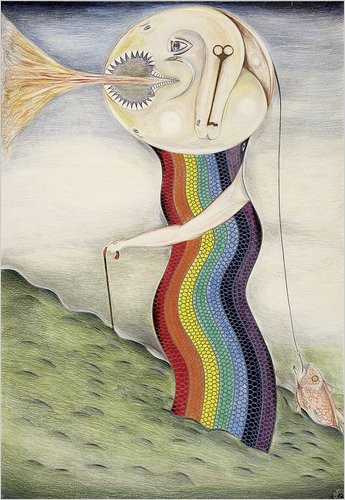
Cuando tenía 20 años se mudó a Berlín, haciéndose pasar por el Prof. Dr. Eliot Gnass von Sonnenstern, un astrólogo, clarividente y quiromántico, suministrando remedios naturales para la salud y vendiendo esperanza mística a la población confundida durante los años de Weimar. A menudo regalaba sus ganancias a los pobres y hambrientos. Esto terminó con la prohibición de las prácticas ocultas por parte de los nazis, y después de ser recluido en institutos psiquiátricos y en un campo penal, resurgió en 1944, rebuscando leña en Berlín que, en ese momento, se estaba reduciendo a un estado ruinoso a través de los bombardeos aliados.
En 1949, aunque estaba cerca de los cincuenta años y nunca había tenido una formación artística formal, comenzó a dibujar, utilizando lápices de colores para crear imágenes alegóricas y, a menudo, sexuales, basándose en una iconografía personal que incorporaba pechos redondos y nalgas igualmente redondas, serpientes , caballos, pequeños soles sonrientes, alas de ángel, ojos flotantes, arcoíris y espirales. A menudo volvía a reelaborar ciertos temas. Aunque su arte rara vez se mostró, fue defendido en los círculos surrealistas y Art Brut. Jean Dubuffet y Hans Bellmer se encontraban entre sus admiradores, y algunos de sus dibujos se incluyeron en la Exposition internationale du Surréalisme de Marcel Duchamp y André Breton de 1959.en París. Su trabajo fue a menudo satírico y políticamente cargado, aunque sus imágenes son claramente surrealistas y recuerdan un poco el estilo posterior de Victor Brauner.
Después de la muerte de Möller, su compañero, en 1964, Schröder-Sonnenstern se dio a la bebida, su arte se deterioró y, a medida que cambiaron los gustos artísticos, fue etiquetado como un artista 'Outsider' y, en consecuencia, relegado a los márgenes de la historia del arte.
En 2011, la Michael Werner Gallery de Nueva York llevó a cabo una exposición de su obra, comisariada por Pamela Kort, From Barefoot Prophet to Avant-Garde Artist , que ha ayudado a restablecer el lugar que le corresponde como figura formativa en la Alemania de la posguerra. arte surrealista.
#Friedrich Schröder-Sonnenstern nació en 1892 cerca de Tilsit en Prusia Oriental y fue dudosamente diagnosticado como esquizofrénico cuando e#¿Historias cortas para no dormir?#surrealismo
4 notes
·
View notes
Text
Unsolved wiki johnny lee wilson

UNSOLVED WIKI JOHNNY LEE WILSON SERIAL
Pratt, Erik Jan Hanussen, Faith Hedgepeth homicide, February 2007 Salvadoran congressmen killings, Fereydoun Farrokhzad, Fidan Doğan, Florence Broadhurst, Gareth Jones (journalist), Gary DeVore, Gerald Bull, Gerard Davison, Geylang Bahru Family Murders, Giangiacomo Feltrinelli, Godard family disappearance, Gottlieb Fluhmann, Halsman murder case, Harry Dudkin, Harvey and Jeannette Crewe, Henryk Siwiak homicide, Herbert Chitepo, Huang Yuanyong, Isdal Woman, Ita Martadinata Haryono, Jackie Coulter (loyalist), Jam Master Jay, Jane Thurgood-Dove, Janet Smith case, Jay Ferdinand Towner, Joachim Peiper, John Kituyi, Johnny Lee Wilson case, Jonathan Luna, Joseph Barboza, Josslyn Hay, 22nd Earl of Erroll, Judy Smith homicide, Keddie murders, Kerry Babies case, Lake Bodom murders, Lava Lake murders, Lead Masks Case, List of murder convictions without a body, List of people who disappeared mysteriously, List of solved missing persons cases, Lists of murders, Louis Allen, Malcolm Caldwell, Marcel Francisci, Marcia Moore, Mark Moran (criminal), Martin DeFoor, Mary Rogers, Matsukawa derailment, Michele Sindona, Mineral, Washington murders, Murder of Atcel Olmedo, Murder of Betsy Aardsma, Murder of Betty Shanks, Murder of Carol Cole, Murder of Carolyn Wasilewski, Murder of Catherine Cesnik, Murder of David Reed, Murder of David Stack, Murder of Harry and Harriette Moore, Murder of Jaclyn Dowaliby, Murder of Joe Cole, Murder of Lindsay Buziak, Murder of Marcia King, Murder of Margaret Martin, Murder of Melanie Carpenter, Murder of Michael Nigg, Murder of Michelle Garvey, Murder of Miranda Fenner, Murder of Pamela Werner, Murder of Raonaid Murray, Murder of Robert Eric Wone, Murder of Seth Rich, Murder of Simon Dale, Murder of Stephanie Crowe, Murder of Susan Poupart, Murder of the Grimes sisters, Murder of The Notorious B.I.G., Murder of Tupac Shakur, Murder of Udin, Murders of Abigail Williams and Liberty German, Murders of Kerry Graham and Francine Trimble, Murders of Margaret and Seana Tapp, Murders of Sally McNelly and Shane Stewart, Muzafar Bhutto, My Favorite Murder, Natalie Wood, National Airlines Flight 2511, Oklahoma Girl Scout murders, Paul Cunniffe, Paula Hounslea, Paxton Boys, Peggy Hettrick murder case, Peter Bergmann Case, Pike County, Ohio, shootings, Piotr Jaroszewicz, Raymond Washington, Reşat Amet, Redhead murders, Richard Lancelyn Green, Robert Donati, Robert Johnson, Robison family murders, Rodney Marks, Ryan W. , Death of Manon Dubé, Death of Mitrice Richardson, Death of Nicole van den Hurk, Death Valley Germans, Deaths of John and Joyce Sheridan, Deaths of Kris Kremers and Lisanne Froon, Dino Bravo, Dolores Della Penna, Dursun Aksoy, Edwin T. ġ98 relations: Adolph Dubs, Aerolinee Itavia Flight 870, Alas Chiricanas Flight 901, Albert DeSalvo, Alberto Nisman, Allen Dorfman, Alphonse Gangitano, Arnold Schuster, Arthur Brennan, Assassination of Haim Arlosoroff, Assassination of Mahmoud Al-Mabhouh, Ötzi, Babes in the Wood murders (Stanley Park), Bain family murders, Bashir Ahmed Qureshi, Battersea Mystery, Bisoye Tejuoso, Black Dahlia, Black Donnellys, Blackfriars Massacre, Bogle–Chandler case, Bola Ige, Boris Berezovsky (businessman), Bowraville murders, Brian Spencer, Burger Chef murders, Canadian Pacific Air Lines Flight 21, Carlos Muniz Varela, Chandra Levy, Chinx, Clarence 13X, Counter-Guerrilla, Crawford family murder, Cyprus Airways Flight 284, Dacer–Corbito double murder case, Dardeen family homicides, Death and state funeral of Muhammad Zia-ul-Haq, Death of Alberto Nisman, Death of Alexander the Great, Death of Ambrose Ball, Death of Andrew Sadek, Death of Barbara Precht, Death of Caylee Anthony, Death of Corryn Rayney, Death of Dave Walker, Death of Gareth Williams, Death of Jeremiah Duggan, Death of Joan Robinson Hill, Death of Katrien De Cuyper, Death of Kendrick Johnson.
UNSOLVED WIKI JOHNNY LEE WILSON SERIAL
This list of unsolved deaths includes notable cases where victims have been murdered or have died under unsolved circumstances, including murders committed by unknown serial killers.

0 notes
Photo

The Many Questions in Pamela Werner’s Murder
The murder of Pamela Werner is as gruesome as it is complicated. It has remained unsolved for over 80 years and the theories as to who killed her are wildly different.
Pamela was the 19 year old adopted daughter of British diplomat Edward Werner, an expert in Chinese culture. They both lived in Peking (now Beijing), but the teenager was preparing to leave China to study in London.
On January 8, 1937, Pamela met a couple of female friends to go to an ice skating rink, where she stayed until 7:30 pm. She was expected at home for dinner at 8 pm, but she never made it. Instead, her body was found the next morning, horribly mutilated, near Fox Tower, a short distance from her house.
A warning here, for disturbing details. Pamela had suffered blunt force trauma on the head that had fractured her skull. She’d been severely beaten and stabbed, her head and right arm had been cut so deeply they barely remained attached to the rest of her body. The autopsy would later determine that her blood had been drained and most of her organs had been removed, including the heart. Although she was still wearing her coat, her underwear was missing; however, it was impossible to determine if she’d been sexually assaulted, since her killer had penetrated her vagina multiple times with a knife, destroying any evidence.
Considering the extreme attack and the lack of blood at the place where the body was found, the investigators concluded that Pamela had been killed somewhere else. Her watch had been stopped shortly after midnight and the contents in her stomach helped set the likely time of her death at between 10 pm and 2 am.
The investigation was very difficult, not only because Pamela was part of a prominent european family, which required british police to get involved and work along the chinese authorities, but also because at the time Peking was in turmoil and soon to be occupied by the Japanese. Once this happened, the case was virtually closed without resolution and Edward Werner continued gathering clues by himself until his death in 1954.
There’s a book about this case called Midnight in Peking, by british author Paul French, which became a best seller after it was published in 2011. In it, French puts forward the theory that Edward Werner himself believed in regards to who murdered his daughter. This theory proposes that, after leaving the ice rink, Pamela was lured by some men to what she thought was a party, only to discover it was really a brothel where she would be sexually abused. When she showed resistance, she was killed and her blood drained to make it easier to move the body. French believes that the people involved in the murder were experienced in hunting and that’s the reason behind the taking of the organs. He also names American dentist Wentworth Prentice, who lived in Peking at the time, as the organizer of this “party” and the main suspect in Pamela’s murder.
In 2018, a second book about the case was published that contradicts most of French’s claims. Written by retired british police officer Graeme Sheppard, A Death in Peking proposes that Pamela was killed by a chinese citizen and former schoolmate, Han Shou-ching, who was apparently romantically interested in her. Something that the british inspector who was overseeing the case was convinced of. Sheppard also suggests that the organs might have been taken by others who found the body and sold them for superstitious chinese medicine practices.
#true crime#tcoriginal#unsolved murder#cold case#pamela werner#midnight in peking#death in peking#mystery#unsolved
107 notes
·
View notes
Text
one minute i’m doing some surface level research for my book the next i’ve been reading about a 1937 cold case for the past fifteen minutes this is no way to live life
6 notes
·
View notes
Photo

While Batman has a thing about keeping metas out of Gotham, his enemies are a little more forgiving. They're actually more likely to be friendly towards metas and aliens than regular humans. Catch Harley Quinn kicking Count Vertigo into Gotham River for being a terrible uncle; spy Poison Ivy dangling Lex Luthor off a very tall building; records have surfaced of Scarecrow dosing half the Central City Rogues for trespassing. It's a THING.
@augment-techs
#batman#bruce wayne#metahumans#gotham#aliens#humans#harley quinn#harleen quinzel#count vertigo#werner vertigo#poison ivy#pamela isley#lex luthor#scarecrow#jonathan crane#central city#rogues#flash rogues
282 notes
·
View notes
Text
Part Eight - Fruits of the Looms: With Legendary Players, Rivalries, Remarkable Feats, and Urban Legends, Textile Leagues Forever Shaped the Game of Baseball in Woodruff
Part Eight – Fruits of the Looms: With Legendary Players, Rivalries, Remarkable Feats, and Urban Legends, Textile Leagues Forever Shaped the Game of Baseball in Woodruff
Moments That Changed Wolverine History: Part Eight of a 12-Part Series Looking Back at Events Which Changed the Landscape of Woodruff Athletics
By: Garrett Mitchell, Staff Writer
When stories are handed down from one generation to the next, passed from their era by those who witnessed them to the generations and ages that follow, it is presumably easy to blur the line between reality and myth…

View On WordPress
#Garrett Mitchell#Hamm Werner#Mill#Mills Mill Pals#Moments in History#Ox Taylor#Pamela Chaffin#Sammy Taylor#The woodruff times
2 notes
·
View notes
Text
The 2018 Interviews on China with artists, photographers, directors, writers, and academics
New Post has been published on https://china-underground.com/2018/12/31/china-interviews-2018/
The 2018 Interviews on China with artists, photographers, directors, writers, and academics
A series of exclusive interviews on Chinese culture: from the environment to politics, architecture, LGBT rights, contemporary art, literature, comics, social rights, women in China, the Taiwanese question, the new Silk Road, poetry, documentaries, history, fashion, dance, rock, and cinema!
A goldmine of first-hand stories about China and Chinese culture.
All the interviews were conducted by Dominique Musorrafiti and Matteo Damiani.
Many of the interviews have appeared in our new free digital magazine Planet China.
Interviews
Interviews are listed in chronological order
Captain China – Interview: Chi Wang, comic author
Interview with Teng Biao, founder of Open Constitution Initiative: the crackdown on Chinese civil society will continue
Interview with Elle Lee, Style Blogger
Interview with Matina Cheung: Teaching Yoga in Hong Kong
Interview with Heanney McCollum, Personal Trainer & Lifestyle Coach in Hong Kong
Mountain Forest Hotel Guizhou aims to create a real green forest valley, to shape a new model of future life. The design concept will follow ecology to create a real forest city for the residents. The recyclable energies and techniques will be introduced to ensure sustainable energy use.
Interview with Forest Revolution and Urban Forestry pioneer Stefano Boeri
Interview: Josh Summers on Traveling in Xinjiang
Interview with Analyst J. Michael Cole On Xi Jinping’s power grab and the risks of the New Silk Road
Interview with Hua Dong, Re-Tros: Before the Applause and Beyond
Yan Hua Wang Taichi Master
Interview with Tang Min, Ballet Mistress of the Hong Kong Ballet
Interview with Yang Ruiqi: my life is all about dancing
Anita Wong: Modern & Tradition
The Fabulous World of Qin Leng
Helen Feng Interview: Don’t settle for okay . . . be better
Zhuo Danting, China’s Queen of Tattoos
The Art of Min Liu
Thierry Chow, Feng Shui master
Interview with Simon Chung, film director
Augusta Xu-Holland: Between Art&Science
The Evolution of China’s Environmental Policy: Interview with Michael Standaert
Interview with Li Wei, the creator of stunning art images playing with gravity
Interview with author Jeremy Tiang
Interview with New York-based freelance illustrator Lisk Feng
Interview with artist Ming You Xu
Interview with Soprano Hui He
Chiara Ye – Food photographer, menu designer and F&B visual strategist
Yummy and healthy visual experience with Chiara Ye
The Blind Youth of He Sen – Interview (2004)
Jia Zhangke and Wang Xiaoshuai at BigScreen Italia 2006, Kunming, China
Interview with director Wang Xiaoshuai (2004)
Interview with Piero Kuang Sung Ling founder and coordinator of Slow Food Great China
12m2 1994, Performance, Beijing, China
Interview with contemporary artist ZHANG HUAN
Interview with Manya Koetse: sinologist & founder of What’s on Weibo
Interview with GuiGuiSuiSui
Interview with RongRong & Inri
Interview with Rebecca F. Kuang, author of ‘The Poppy War’
Interview with Lance Crayon: The origins of graffiti in Beijing
Herman Lee: T-Shirt Designer, Graphic Designer, and Illustrator
Interview with Badiucao, political cartoonist, and rights activist
Interview with Helen Zia, author and activist
Interview with Joanne Leung: LGBTQ rights in Hong Kong
Interview with Shanghai Pride: LGBTQ Rights in Shanghai
Interview: Beijing LGBT Center
Interview with Ah Qiang, PFLAG China: LGBT rights in Guangzhou
Interview: No.223, Art Photographer
Lin Jun Liang: Art from Inside Out
China’s authoritarian control system – Interview with Patrick Poon, Researcher at Amnesty International
The Murder of Pamela Werner: Interview with Graeme Sheppard
Lucie Liu’s TaipeiLove*: Taiwan’s unique journey towards same-sex marriage and equality
Chen Chen. Author: Keegan Lester
Interview with Chen Chen, author and poet
topic: China interviews, China experts, China facts
#ChineseDirector, #ChinesePhotographer, #ChinesePoet, #ChineseWriter, #Interview
2 notes
·
View notes
Photo
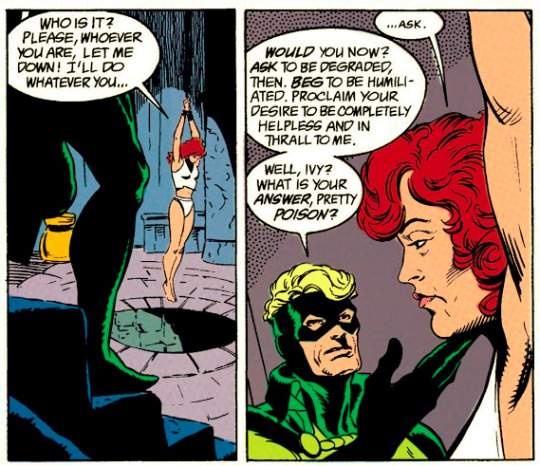
This is getting way too kinky for my tastes...
7 notes
·
View notes
Note
Hi! Do you have recs for readings on book history or manuscript studies? Codicology and paleography are my new fave topics and I can’t get enough!
hello! i am so sorry for taking forever on this. partly why-- besides, like, life-- is that codicology and paleography are not my areas of expertise (i tend towards the 16th-18th centuries) so thank you for giving the me the opportunity to dive into them!!
Book History:
DF Mckenzie, Bibliography and the Sociology of Texts
Alan Galey, "The Enkindling Reciter: E-Books in the Bibliographical Imagination"
Sarah Werner, Studying Early Printed Books
Kate Ozmat, “Rationale for Feminist Bibliography”
Joanna Brooks, “The Unfortunates: What the Life Spans of Early Black Books Tell Us About Book History” Early African American Print Culture eds Lara Langer Cohen and Jordan A. Stein
Codicology and Paleography:
David Rundle, ed Cambridge Studies in Palaeography and Codicology (series)
Malte Rehbein, Patrick Sahle, Torsten Schassan, Codicology and Palaeography in the Digital Age
ASG Edwards "What is Palaeography For?"
Sébastien Barret, Dominique Stutzmann, and Georg Vogeler, eds. Ruling the Script in the Middle Ages: Formal Aspects of Written Communication
Jane Roberts, Pamela Robinson, "Paleography and Codicology" (The entire book, A Companion to the History of the Book eds Simon Eliot and Jonathan Rose, is a great resource)
#regular disclaimer that i'm a lit phd#not a historian#but i hope these are helpful!!#this was so fun#studyblr#gradblr#grad school#gradblogging#early modern lit#study#manuscript studies#resource tag
48 notes
·
View notes
Text
Esta es la imagen y algunos datos (O no) la “Historia” la pones tú ¡La tuya! ¿Lo harás?… Web del Surrealismo. Friedrich Schröder-Sonnenstern (1892 - 1982)
Friedrich Schröder-Sonnenstern nació en 1892 cerca de Tilsit, en Prusia Oriental, y fue dudosamente diagnosticado como esquizofrénico cuando era joven. Pasó un tiempo en hospitales psiquiátricos, así como en prisiones por delitos menores.

Cuando tenía 20 años se mudó a Berlín, haciéndose pasar por el Prof. Dr. Eliot Gnass von Sonnenstern, un astrólogo, clarividente y quiromántico, suministrando remedios naturales para la salud y vendiendo esperanza mística a la población confundida durante los años de Weimar. A menudo regalaba sus ganancias a los pobres y hambrientos. Esto terminó con la prohibición de las prácticas ocultas por parte de los nazis, y después de ser recluido en institutos psiquiátricos y en un campo penal, resurgió en 1944, rebuscando leña en Berlín que, en ese momento, se estaba reduciendo a un estado ruinoso a través de los bombardeos aliados.
En 1949, aunque estaba cerca de los cincuenta años y nunca había tenido una formación artística formal, comenzó a dibujar, utilizando lápices de colores para crear imágenes alegóricas y, a menudo, sexuales, basándose en una iconografía personal que incorporaba pechos redondos y nalgas igualmente redondas, serpientes , caballos, pequeños soles sonrientes, alas de ángel, ojos flotantes, arcoíris y espirales. A menudo volvía a reelaborar ciertos temas. Aunque su arte rara vez se mostró, fue defendido en los círculos surrealistas y Art Brut. Jean Dubuffet y Hans Bellmer se encontraban entre sus admiradores, y algunos de sus dibujos se incluyeron en la Exposition internationale du Surréalisme de Marcel Duchamp y André Breton de 1959.en París. Su trabajo fue a menudo satírico y políticamente cargado, aunque sus imágenes son claramente surrealistas y recuerdan un poco el estilo posterior de Victor Brauner.
Después de la muerte de Möller, su compañero, en 1964, Schröder-Sonnenstern se dio a la bebida, su arte se deterioró y, a medida que cambiaron los gustos artísticos, fue etiquetado como un artista 'Outsider' y, en consecuencia, relegado a los márgenes de la historia del arte.
En 2011, la Michael Werner Gallery de Nueva York llevó a cabo una exposición de su obra, comisariada por Pamela Kort, From Barefoot Prophet to Avant-Garde Artist , que ha ayudado a restablecer el lugar que le corresponde como figura formativa en la Alemania de la posguerra. arte surrealista.
#Friedrich Schröder-Sonnenstern nació en 1892 cerca de Tilsit en Prusia Oriental y fue dudosamente diagnosticado como esquizofrénico cuando e#surrealismo#¿Historias cortas para no dormir?
0 notes
Text
Klonoa Chronicles #78
Klonoa Chronicles is a series of tweets by Klonoa’s original creator, Hideo Yoshizawa, that give insights into the development of the games he had a hand in making. Below is a translation along with the original Japanese text.
クロノアクロニクル 第78回 今回もわたしが最初に描いたパペットDISP.の絵コンテの解説を。
Klonoa Chronicles #78! Again, I would like to explain the storyboard of the first Puppet DISP. that I drew.

じっちゃんの名前がダルスおんじになってます!ダルスというのはラディア戦記に登場するキャラの名前です。おんじというのは「アルプスの少女ハイジ」のアルムおんじから来ています。この世界が人々の忘れてしまった夢からできていることを言ってますが、説明臭いので製品版ではカットされてます。
Grandpa’s name was originally Darus here, based off the character who appears in Radia Senki, who was also based off the grandfather in the tv show Heidi, Girl of the Alps. He explains the legend that the world is made from the dreams that people have forgotten, but this was cut from the final version.

水が来ないために先に進めないというシチュエーションの説明的セリフですね。ここら辺はあらゐくんが上手に膨らませてくれて、可愛い水の国の兵士が誕生しました。「~でち」という赤ちゃん言葉のようなセリフはおもしろいですよね。
Here it is explained why you cannot go further because the flow of water has stopped. It was here, Mr. Arai created a cute and round-shaped Water Kingdom soldier to talk with. They’re babyish adding “~dechi‘ to the end of their sentences.

滝が逆流しているっていうのは真っ先に浮かんだイメージで、むしろこれをやりたいがために水が途絶えて木が枯れて先に進めないっていうのを考えたと言ってもいいぐらいです。 ちなみに城の名前がシェル城になってますね。貝だけに、ね。
The image of a waterfall flowing backwards was the first image that came to mind. I would even go so far as to say that I thought of the idea of a backwards waterfall where the water is cut off, the trees die, and you can't move on because of it. By the way, the name of the castle is Shell Castle, just like a shellfish.
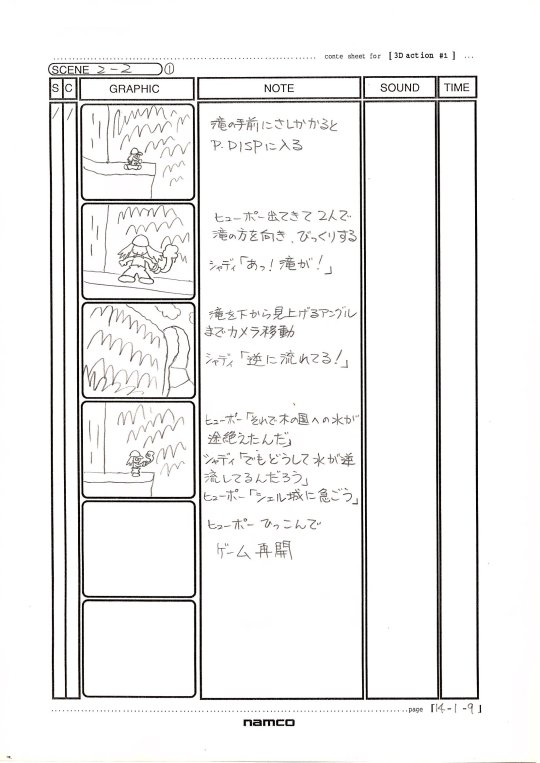
小魚に乗って登場するのは、確かこの前のステージで小魚に乗って移動しながらのアクションを考えていたからだったと思います。段々城が近付いてきて、城の周りを一周あおりのアングルで見せるという。ちなみにパメラは王様の名前になってますね。製品版ではシードフ王、これは水だけにシーフードから。
Previously, the boss appeared as a small fish riding on a larger fish. The castle was given a round shape to create a curved shape for the boss arena. By the way, Pamela was originally the name of the king. In the final version, Seadoph became the name of the king because it sounded more aquatic.

そしてパメラはフィッツと呼ばれていますね。これはヴェルナー・ヘルツォークの映画「フィッツカラルド」から取っています。だからその子供はカラルって名前なんですよ。 さらにフィッツカラルドはラディア戦記では木製の飛行船の名前です。 つづく
Pamela herself was originally named Fitz. This was inspired by Werner Herzog’s film Fitzcarraldo. That’s actually why her child is named Karal. (The name Karal is derived from Fitz-carral-do.) In addition, Fitzcarraldo is the name of the wooden airship in Radia Senki also. To be continued.

11 notes
·
View notes
